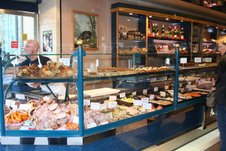Delicata Squash Roasted with Bourbon Barrel Aged Maple Syrup
Another roasted winter squash recipe? Really? How many does a home cook really need?
I hear you. Really I do. But I just know you're going to fall over for this--and maybe want to add it as a Thanksgiving side. Yeah, it's that good.
My inspiration was a bottle of Trader Joe's Organic Vermont Maple Syrup, Bourbon Barrel Aged. I admit it. I was lured by the Fearless Flyer's description and bought a bottle within the week. Then it sat in my pantry until I picked up a Delicata squash last week.
I love this squash. It's already sweet, the skin is tender--even the seeds are delicious roasted. I literally stood and stared at it the other night, willing inspiration. And it hit. I peeled and minced a couple of cloves of garlic, pulled out some dried Greek oregano and Chimayo red chile powder, which has a smoky heat I love (you can use regular chile powder if you can't easily access this), and ground some sea salt.
Next I pre-heated my oven to 400°. Then I sliced the squash in half lengthwise, cleaned the seeds and pulp out of the center, then sliced the halves crosswise into pieces about half an inch wide. I put them into a medium-size bowl, and added the garlic, oregano, chile powder, and salt. I mixed it all up with a nice helping of extra virgin olive oil, then spread the pieces onto a baking sheet lined with parchment paper. And, then, of course, came the maple syrup. I drizzled the syrup over the pieces, then grabbed a pastry brush and made sure each piece was covered in the syrup. Into the oven the baking sheet went.
Half an hour later, the Delicata squash was beautifully browned. I popped a piece into my mouth and swooned. The syrup had permeated the squash and married with the chile powder to give a sweet, smoky heat. The garlic made sure it wasn't cloyingly sweet. It was like eating veggie candy.
Eat. Repeat next week.
Delicata Squash Roasted with Bourbon Barrel Aged Maple Syrup
Serves 2
(printable recipe)
Ingredients
1 Delicata squash
2 cloves garlic, peeled and minced
1/2 teaspoon dried Greek oregano
1 teaspoon Chimayo red chile powder
Sea salt to taste
1/4 cup extra virgin olive oil
Organic Vermont maple syrup, preferably bourbon barrel aged
Directions
Pre-heat oven to 400°.
Slice the squash in half lengthwise, clean the fibrous pulp and seeds (save for roasting) out of the center, then slice the halves crosswise into pieces about half an inch wide. Place in a medium-size bowl.
Add the garlic, oregano, chile powder, and salt. Mix together with the olive oil.
Spread out the Delicata squash slices onto a baking sheet lined with parchment paper. Make sure they don't overlap. Then drizzle the maple syrup over the slices. Use a pastry brush to brush the syrup onto each slice of squash. Place in the center of the oven and roast for 30 minutes or until golden brown. It's best served immediately, but, surprise, it's also delicious cold the next day.
Print Page















































